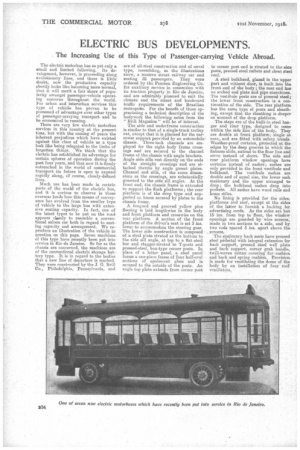ELECTRIC BUS DEVELOPMENTS.
Page 14

If you've noticed an error in this article please click here to report it so we can fix it.
The Increasing Use of this Type of Passenger-carrying Vehicle Abroad.
The electric motorbus has as yet only a email and limited following. Its development, however, is proceeding along evolutiouary lines, and there is little doubt, now the productive capacity shortly looks like becoming more normal, that it will merit a fair share of popularity amongst passenger-vehicle operating concerns throughout the world. For urban and interurban services this type of vehicle has proven to be possessed of advantages over other types of passenger-carrying transport and to be economical in running. There are very few electric motorbus services in this country at the present time, but with the coming of peace the inherent prejudices which have existed against this class of vehicle as a type look like being relegated to the limbo of forgotten things. . We think that the electric has established its advantage for certain spheres of operation during the past four years, and that now it is firmly entrenched in the world of commercial transport its future is open to expand rapidly along, of course, closely-defined lines.
Much use has been made in certain parts of the world of the electric bus, and it is curious to observe in these overseas lands how this means of conveyance has evolved from the smaller type of vehicle to the large bus with extensive seating capacity. In fact, one of the latest types to be put on the road appears clasely to resemble a conventional saloon car both in regard to seat
ing capacity and arrangement.reproduce an illustration of the ehicle in question on this page. Seven machines of this type have recently been put into service in Rio de Janeiro. So far as the chassis are concerned, the machines are of the conventional electric storage battery type. It is in regard to the bodies that a new line of departure is marked. They were constructed by the J. G. Brill Co., Philadelphia, Pennsylvania, and
are of all-steel construction and of novel type, resembling, as the illustrations snow, a modern street railway car and seating 32 passengers. They were ordered by the Pearson Engineering Co. for auxiliary service in connection with its traction property in Rio de Janeiro, and are admirably planned to suit the climate and the street and boulevard traffic requirements of the Brazilian metropolis. For the benefit of those appreciating a technical description of the bodywork the following. notes from the "Brill Magazine" will be of interest.
The side and underframe construction is similar to that of a single-truck trolley car, except that it is planned for the narrower support provided by an automobile chassis. Three-inch channels are employed for the eight body frame crossings and are secured to the channel frame of the chassis with angle brackets. Angle side sills rest directly on the ends of the straight crossings and are attached thereto by angle gusset plates. Channel end sills, of the same dimensions as the crossings, are substantially gusseted to the side sill angles. At the front end, the chassis frame is extended to support the flush platforms ; the rear platform is of the drop type and supported on knees secured by plates to the chassis frame.
A tongued and grooved yellow pine flooring is laid lengthwise in the body and front platform and crosswise on tha rear platform. A section of the front platform of the driver's seat is set 3 ins, lower to accommodate the steering gear. The lower side construction is composed of a steel plate riveted at the bottom to the side sill angle, at top to a flat steel bar and stagger-riveted to T-posts and pressed-steel, box-type corner posts. In place of a letter panel, a steel panel forms a one-piece frame of four half-oval sections of opalescent glass and is secured to the outside of the posts. An angle top plate extends from corner post to corner post. and is riveted to the side posts, pressed steel rafters and sheet steel roof.
A steel bulkhead, glazed in the upper part and without door, is built into the front end of the body ; the rear end has an arched end plate and pipe stanchions. The vestibule posts are of pressed steel; the lower front construction is a continuation of the side. The rear platform has the same type of posts and sheathing, except that the sheathing is deeper on account of the drop platform.
The steps are of the built-in steel hanger and riser type, designed to come within the side line of the body. They are double at front platform, single at rear,, and are fitted with safety treads. Weather-proof curtains, protected at the edges by the deep grooves in which the fixtures slide, extend to the floor line and serve instead of doors. The side and rear platform window openings have curtains instead of sashes ; Bashes are only provided in the front vestibule and bulkhead. The vestibule sashes are double and of equal size, the lower sash stationary and the upper arranged to drop; the bulkhead sashes drop into pockets. All sashes have wood rails and brass stiles.
No lining is provided for the sides, platforms and roof, except at the sides of the latter to furnish a backing foradvertising cards. As the sides are but 15 ins, from top to floor, the window openings are guarded by wire screens, made in two sections to a side, and by two rods spaced 3 ins, apart above the screens.
The stationary back seats have pressed steel pedestal with integral extension for back support, pressed steel well plate and hark support., corner grab handle, twill-woven rattan covering for cushion and back and spring cushism. Provision, is made for ventilating the dome of the body by an instillation of four roof ventilators.






















